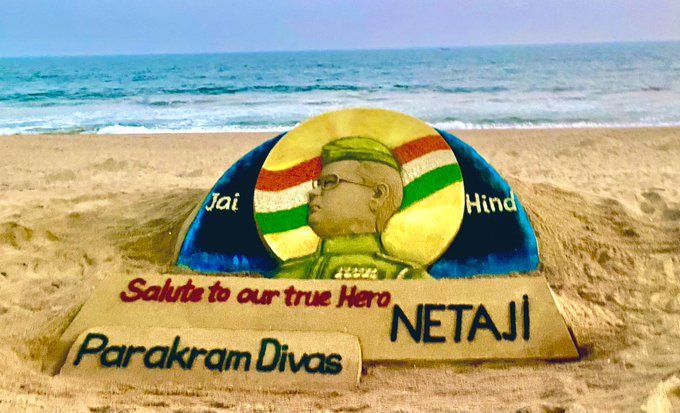Netaji Subhash Chandra Bose in 1944 demanded hundreds of soldiers to bear a desire to face a martyr’s death, to avenge the soldier’s blood the enemy spilled and to fight till the last breath, all for a fair price of freedom. But his voice that rallied hundreds of people to take part in India’s freedom movement was lost in August 1945; that too in thin air.
Bose left behind an empty canvas for historians and diplomats to make paintings, for nothing wears true till date.
It was only in 2015 that the West Bengal government released all the secret files related to Netaji Subhas Chandra Bose from the state archives. The Central Government declassified the remaining 304 files on Bose in 2015, bringing the final number to 2,324. On March 2, 2016, the government declared in parliament that there was no more classified ‘Netaji files’ left in its archives.
These files proved that about ten investigations took place between 1945 and 1974. But all of them confirmed the same story. A theory that was tagged legitimate for long, confirmed Bose’s death on August 18, 1945 after his overloaded plane crashed in Japanese-ruled Formosa.
The mechanics saw something fall off the plane before it crashed and exploded into flames. While Bose’s assistant Habibur Rahman fell unconscious for a while, Netaji allegedly wasn’t fatally hurt but completely soaked in gasoline. Both of them managed to get through the flames and make an exit as ‘human torches’ locals described.
According to Joyce Chapman Lebra – a renowned historian– a truck which was utilised as an ambulance rushed Netaji and other injured passengers to the Nanmon Military Hospital, where Dr Taneyoshi Yoshimi, the surgeon-in-charge attended to Netaji at 3 pm.
After witnessing his burns and assessing his situation, Dr Yoshimi doubted he would live. Despite doing everything in their power to treat him, Netaji slipped into a coma and is reported to have died a few hours later, between 9 pm and 10 pm.
The body was cremated two days later and his ashes were carried by a Japanese officer, Lieutenant Tatsuo Hayashida to Tokyo on September 7 and handed over to the President of the Tokyo Indian Independence League, Rama Murti. All the events were confirmed by the Japanese news agency Domei.
Retd Major Gen GD Bakshi in his book, ‘Bose: The Indian Samurai – Netaji and the INA Military Assessment’ suggested another theory. He said that the plane crash was a well-thought-of theory floated by the Japanese to help Netaji escape to the Soviet Union.
According to Bakshi, an Azad Hind Government embassy in Russia hosted Bose and he also made three radio broadcasts from Siberia, which unveiled to the British the truth of his successful escape to the Soviet Union.
The Indian Independent League in 1953 stated that the Japanese officials could neither risk shielding Netaji from the Allies lest he resurface, nor hand him over and endanger relations with India.
To ‘save herself from the wrath of both India and the occupation forces’, Japanese officials first diverted Netaji’s plane, separated him from five of his six associates, and allowed only one to travel with him.
In 1966, Suresh Bose announced to the press that his brother, Subhas, would return in March, making people think about a possibility of Netaji’s return.
In May 1999, the government of India appointed the Justice Mukherjee Commission to investigate the alleged disappearance of Netaji Subhas Chandra Bose in 1945. This followed the two previous official inquiries of 1956 and 1974 that confirmed Netaji had died in Taiwan following a plane crash as reported by the Japanese authorities.
However, the much interesting part comes with Justice Mukherjee Commission of 2005. The more the commission claimed that Netaji didn’t die in the plane crash, they could never come up with evidence. Mukherjee challenged the established theories about Bose’s death from different angles, even bringing DNA tests into the picture, but nothing was proved.
In 2019, a Bengali film titled ‘Legend of Gumnami Baba’ took the country for a ride, commentating on the lines of the Mukherjee Commission Hearings. It supported a theory that described Bose’s life post freedom in simple terms – Gumnami Baba or Bhagwanji in Uttar Pradesh’s Faizabad district.
Referring to Gumnami Baba an extraordinary person, the Allahabad High Court directed the state government in 2013 to set up a panel to end the controversy about his identity. The judicial commission was set up in 2016.
Justice Vishnu Sahai Commission’s report, submitted in 2019, remained inconclusive as it could not determine whether the reclusive sadhu was indeed Netaji in disguise.
Theories, or better-called legends, that state Subhash Chandra Bose turning into a sage or going all the way to Russia or being admitted in the Chinese Army or being prisoned have floated with generations of historians and intellectuals trying to find a way around.







